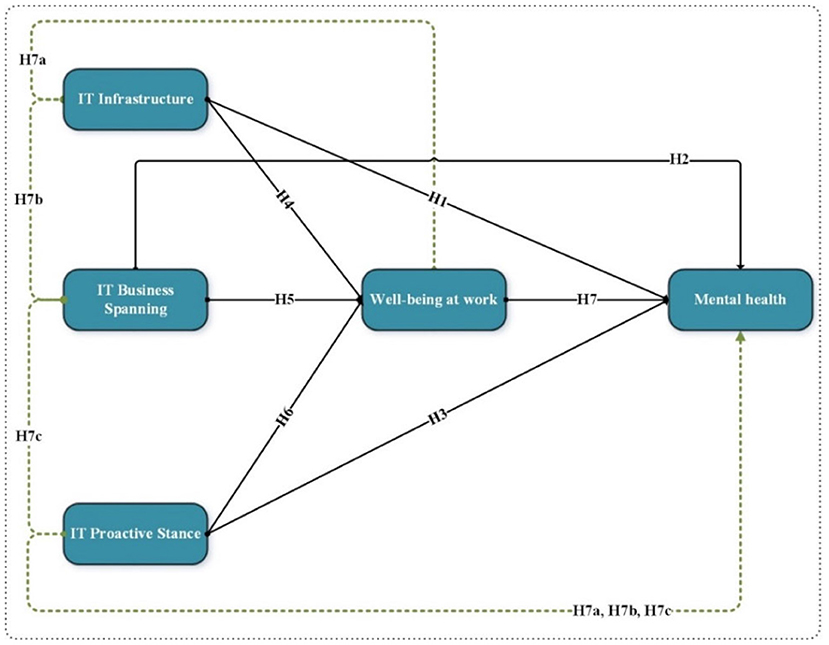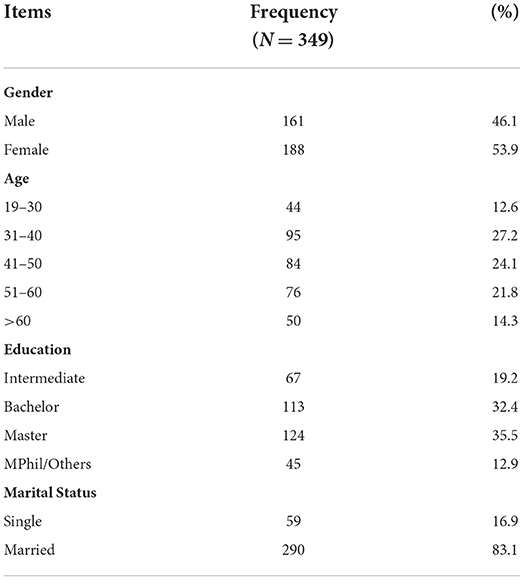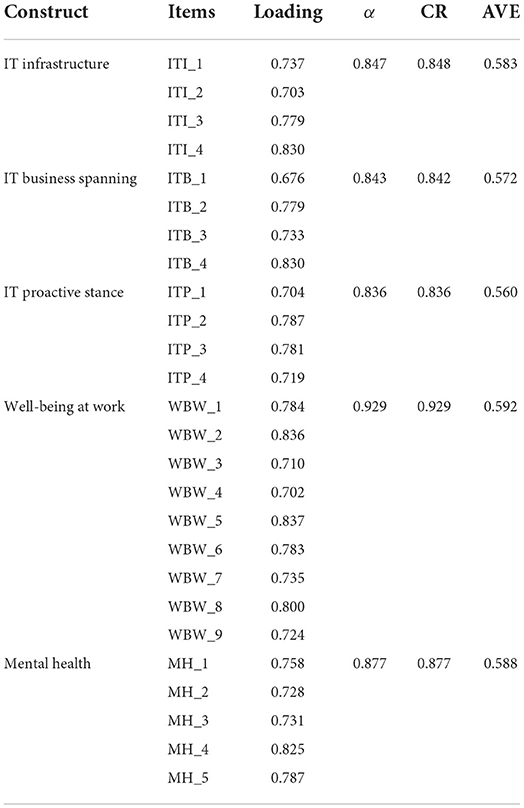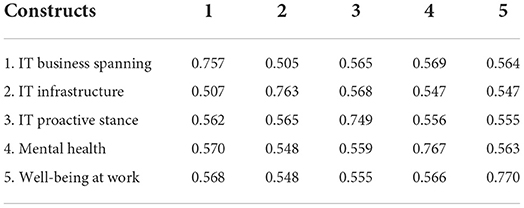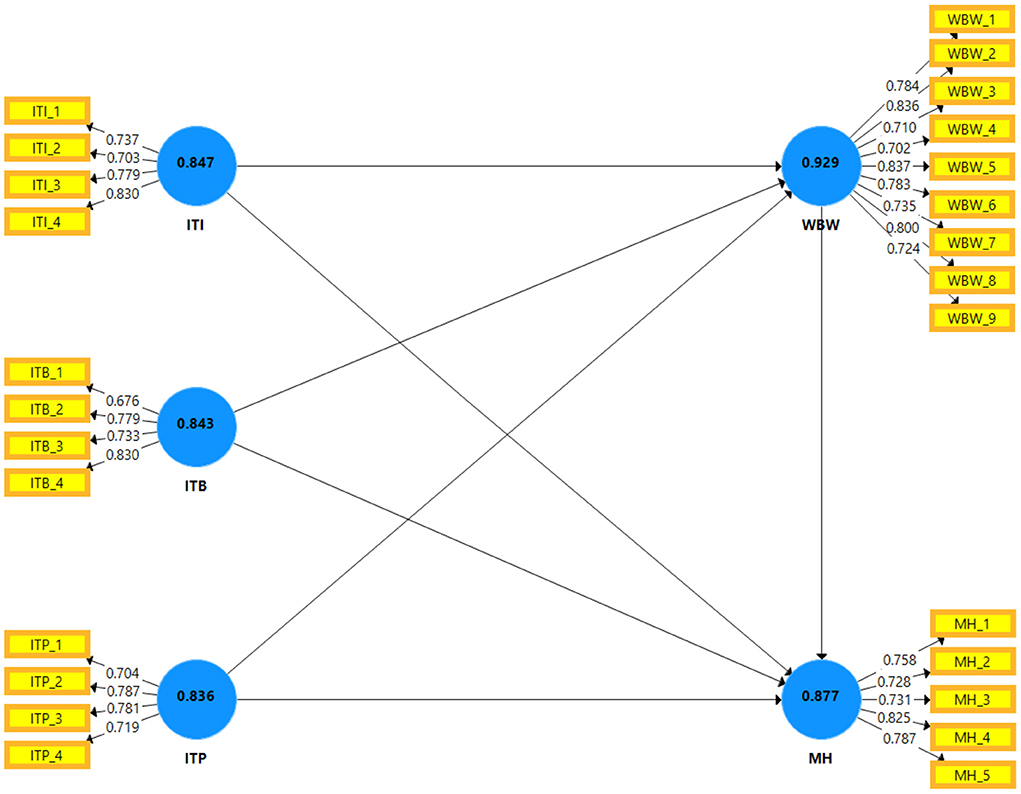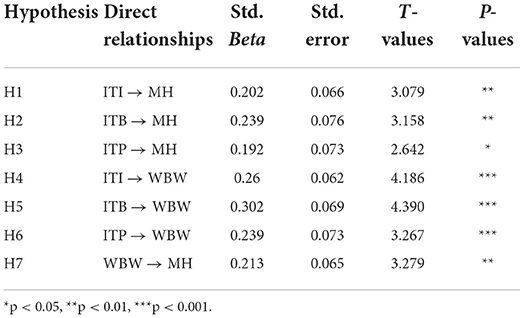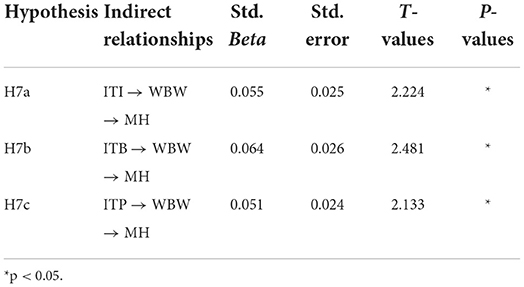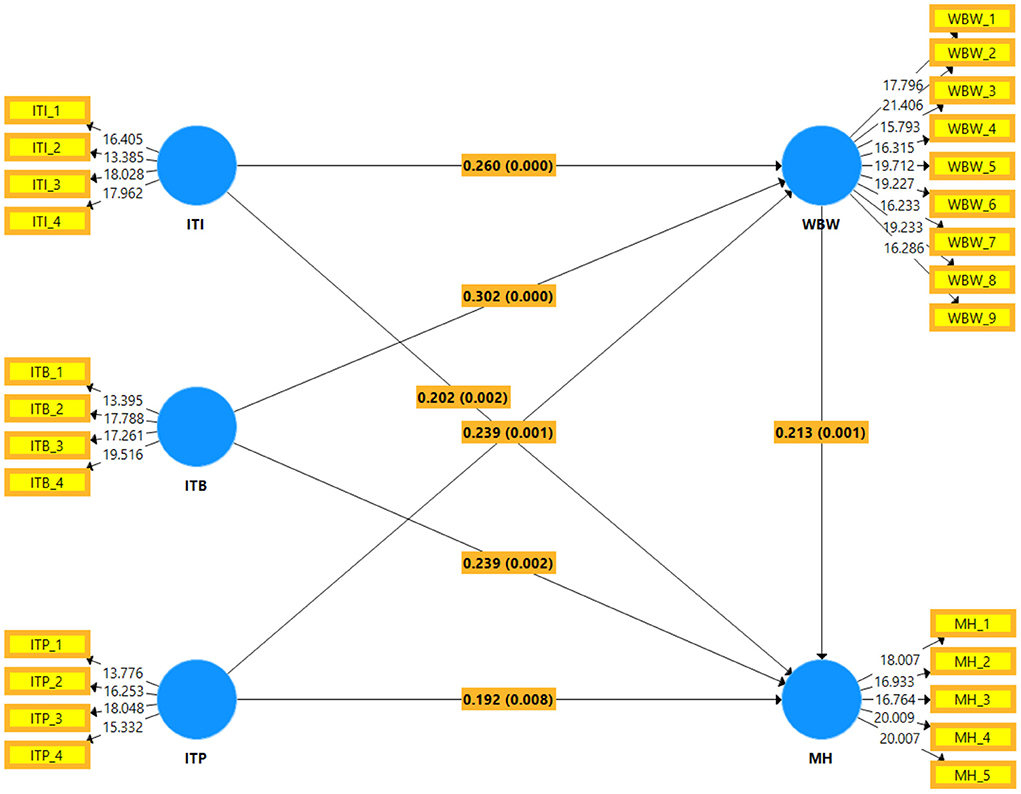- 1School of Management, Nanjing University of Posts and Telecommunications, Nanjing, Jiangsu, China
- 2Department of Commerce and Business, Government College University Faisalabad, Layyah Campus, Layyah, Pakistan
- 3Department of Management Sciences, COMSATS University Islamabad, Lahore Campus, Lahore, Pakistan
- 4Faculty of Economics and Business Administration, West University of Timisoara, Timisoara, Romania
The study aims to measure the mediating relationship of wellbeing at work between digitalization (IT infrastructure, IT business spanning, and IT proactive stance) and their effect on mental health. The study uses primary data collection techniques to gather data and used purposive sampling to analyze the data. The sample size of the study is 349 respondents. The research uses Smart PLS software to measure the relationship through bootstrapping and algorithms. The study finds a significant positive mediating role of wellbeing between digitalization (IT infrastructure, IT business spanning, and IT proactive stance) and their effect on mental health. The study outcomes are helpful for managers and policymakers.
Introduction
In the past decades, technological advancement has profoundly altered global work practices with innovative developments. Significantly, the disruptive digital landscape has become the impetus for novel digitization, substantially overriding traditional digital tools with modern interventions. In recent years, the twenty-first-century modern technological revolution has developed promising digital capabilities to cover humans' personal and professional lives, potentially bringing positive health outcomes (1).
Digitalization is a novel phenomenon that has elevated the use of information technology across various domains. There has been strong demand for its application in the healthcare sector. However, in recent years, the mental health of frontline workers has not received adequate attention despite healthcare being a highly competitive industry in which employees are exposed to significant psychological challenges (2). As such, this literature states that as healthcare psychological problems are accelerating, it has become essential to focus on their impairing impact on employees' overall mental health (3, 4).
Mental health in relation to technology has become a prime interest of current researchers, with some researchers signaling the potential for the use of technology to considerably improve employees' mental health. While in recent years, technology adoption has been shown to bring promising health outcomes in many fields, unfortunately, the value of digital capabilities has not been realized in the healthcare industry (5). One study states that the emerging role of digitalization in the healthcare sector is vital, thus highlighting the need to realize and understand the association between IT capabilities and employees' psychological wellness (6).
The technological solutions implemented across medical domains (e.g., medicine and psychology) are of increasing interest to researchers in terms of novel innovations. Digitalization, a technology-driven notion, has diffused its characteristics into the origin of the healthcare sector. Novel IT capabilities have allowed healthcare organizations to adapt to changing working conditions, thus supporting employees' mental health (7). The real-time access afforded by IT has assisted the hospital industry by optimizing workflow. In fact, in healthcare, the accelerating technological advancement has garnered a tremendous boost to employees' wellbeing. Engaging and involving frontline technical staff in the design and rolling out of new IT infrastructure (ITI) has allowed organizations to understand the value of digital tools in improving employees' mental health.
The ITI alludes to organizations' digital assets such as tools, software, hardware, and applications (8). Significantly, ITI is recognized as a vital tool for fostering employees' mental health (9, 10). Technology is deeply rooted in the health economy, with IT business spanning (ITB) facilities impacting employees' mental health. As such, ITB refers to an organization's ability to adopt novel digital tools, therefore improving firms' operations (11). This novel business capability (i.e., ITB) helps organizations boost employees' mindfulness and productivity (12–14).
In particular, at present, an overwhelming number of technologies are available, meaning organizations need to understand the role of digital innovations in influencing employees' mental health. In this regard, the literature review provides evidence that to ensure the psychological needs of the frontline workers, health institutions should focus on developing technological capabilities for combating the progressing psychological vulnerabilities (15). Therefore, the IT proactive stance (ITP) has become prominent, whereby being forward-thinking about IT is used to achieve the business goal (16). Significantly, to achieve such goals, an organization must ensure its employees' healthy mindset. As a result, the ITP has emerged as a popular tool for ensuring employees' mindfulness.
Significantly, in recent years, occupational digital mental health has played a profound role in eradicating the potential barriers to achieving workplace wellness (17). Numerous factors contribute to elevating workplace problems. However, these increasing psychological vulnerabilities encourage medical institutions to mitigate health issues, thereby ensuring workplace wellbeing (15, 18). A healthy technological environment influences individuals' psychological health and, ultimately, workplace wellbeing and behavior. As a result of IT's increasing significance, organizations are adopting novel IT capabilities for ensuring wellness at work (19).
Undoubtedly, technological abilities have the potential as a global solution to growing psychological vulnerabilities. However, the healthcare sector demands that firms implement digitalization to gain greater attention in the coming decades (20). Technological health interventions provide numerous opportunities to combat the growing health crises. They maximize frontline technical support to establish a healthy environment. However, besides the influential role of technology, the literature shows that current employees are reluctant to adopt digitalization tools (21). In particular, one study states that this fear leads to health organizations lacking technological implementation, adversely influencing employees' psychological wellbeing (22).
However, against this drawback, this study demonstrates a novel conceptual model, presenting a systematic literature review on employees' mental health and workplace wellness. This study consolidates dominant factors that boost employees' mental and workplace wellbeing. Then, to reach a possible conclusion, the study highlights the role of digitalization (e.g., ITI, ITB, and ITP) in influencing employees' mental health. Moreover, it also sheds light on the effect of IT capabilities on workplace wellbeing. In the same vein, the study investigates the mediating role of the wellbeing at work nexus on digitalization and employees' mental health.
Significantly, this study promotes employees' mental health and wellbeing regarding digitalization. In particular, to the best of our knowledge, this study is pioneering in illustrating the role of IT capabilities (e.g., ITI, ITB, and ITP) in influencing employees' mental health. It explains a new concept that highlights the mediating role of wellbeing at work in this context. Therefore, on the scale of digitalization, this study presents valuable knowledge on employees' mental health and wellbeing. The study's findings are targeted toward researchers, policymakers, healthcare institutions, and the medical administration to suggest ways to improve employees' mental wellbeing.
This study comprises six different sections. The next section (i.e., “Literature review”) presents a conceptual model highlighting the study background. The “Methodology” section prescribes the methodological tools and techniques needed for study analysis. The “Results” section explains the analysis results, while the “Discussion” section discusses the significant study outcomes. Finally, the “Conclusion” section concludes the study by suggesting the research findings and implications.
Literature review
IT infrastructure and mental health
In recent years, the rapid advancement in digital technologies has altered the nature of work, thereby requiring employees to radically respond to the technological change. Among these developments, the ITI has emerged as an inevitable tool in assisting employees' workplace activities. The ITI has empowered workers to perform to their potential, thus bringing positive healthcare outcomes. In particular, this mental health innovation (e.g., ITI) is a convenient way of overcoming health crises in the workplace setting (17, 23). In recent years, technology has significantly evolved, bringing numerous opportunities for frontline workers. In explaining this notion, the literature states that, in healthcare, the high potential of digital technology fosters employees' psychological wellbeing and performance (10, 24).
In particular, workplace mental health is structured around modern digital developments. Novel IT innovations reduce the growing health ramifications, thereby engendering positive health outcomes (e.g., psychological wellbeing) (25). In fact, technology's rapid transformation of the world has worked as a catalyst, resolving problems across the healthcare ecosystem. As such, prior research states that digital tools have inevitably made healthcare organizations embrace novel technologies, thus promoting employers' positive psychological wellbeing (26). Overall, with the increasing significance of technology in healthcare, medical institutions should ensure proper utilization of technology to foster employees' mental health. Therefore, in light of the previous literature, the current study suggests the following hypothesis:
H1: IT infrastructure has a positive and significant impact on mental health.
IT business spanning and mental health
Mental health is a significant part of a person's wellbeing. With the growing number of individuals experiencing mental health crises, understanding the impact of technological change has become vital for ensuring individuals' psychological health. Technology integration helps organizations enhance employees' mental health. In the present digital era, IT-enabled advancements (i.e., ITB) are deeply rooted in firms' structures (27). Therefore, in ensuring positive mental health, ITB integrates preventive health technologies into the firm's structure (28, 29).
In particular, at present, the high pace of disruption (e.g., ITB) has updated and transformed firms' activities, shifting researchers' focus to mental wellbeing. The literature suggests that virtual IT platforms have made employees assess their psychological needs, thereby ensuring a higher degree of mindfulness (13, 30, 31). Those working in the hospital industry face high-level psychological issues (e.g., stress, anxiety, and depression). However, the rapid digital developments have profoundly altered the nature of the work, thereby combating the growing health vulnerabilities. As such, the ITB advances employees' mental health by mitigating the psychological risks associated with the workplace (32). Therefore, rather than just implementing technology, firms should build a clear understanding of its use for promoting employees' mindfulness. Consequently, based on the literature, this study proposes the following hypothesis:
H2: IT business spanning has a positive and significant impact on mental health.
IT proactive stance and mental health
In the digitization world, IT capabilities have brought numerous opportunities that support a workplace's mental wellbeing environment. Therefore, the workplace changes derived from the IT tools have encouraged the employees to learn novel tools for minimizing the effect of growing psychological vulnerabilities. As such, the literature states that owing to the effectiveness of the ITP, organizations should quickly respond to the changing workplace needs, optimally predicting the new opportunities (33, 34). In this regard, the ITP helps detect the employees' psychological needs, thereby illuminating the signs of health crises. The ITP provides opportunities to present organizations with critical information regarding their employees' health and wellbeing. Prior research shows that, at present, mental health technology enables organizations to respond to growing health challenges (35). Due to the increasing ITP role, the literature suggests making a high investment in disruptive technologies, thus ensuring positive health outcomes (i.e., psychological wellness) (36). Therefore, in light of the literature review, this study suggests the following hypothesis:
H3: IT proactive stance has a positive and significant impact on mental health.
IT infrastructure, IT business spanning, IT proactive, and wellbeing at work
IT infrastructure and wellbeing at work
In recent years, digitization and the prioritization of ITI have gained firms' attention, thereby nurturing employees' workplace wellbeing. In particular, current focus on employees' wellbeing has profoundly extended beyond just focusing on building a healthy workplace environment. ITI is crucial for maintaining optimal wellbeing (37). It increases employees' happiness and workplace wellbeing (38). Numerous tools have been found to support workplace wellbeing, with studies demonstrating that ITI works as an effective means to ensure employees' workplace wellness (39). Undoubtedly, predicting employees' workplace wellbeing has become the top priority of current firms. Due to information communication technologies (ICTs) growing relevance, the intensified role of ICT improves the employees' wellbeing at work. IT acceleration plays a critical role in managing workplace health issues. As such, the research shows that digital transformation focuses strongly on improving workplace wellbeing (40). In fact, ITI is critical to developing workplace wellbeing. Hence, given the literature review, this study proposed the following hypothesis:
H4: IT infrastructure has a positive and significant impact on wellbeing at work.
IT business spanning and wellbeing at work
Undoubtedly, advancing globalization has allowed IT developments to open new avenues for improving workplace wellbeing. In the context of digital innovation supporting workplace wellness, one study showed that modern development had fostered a change in the nature of work, thus leading to the health interventions (e.g., ITB) to become the prime determinants of workplace wellbeing (41). The digitalization capability (i.e., ITB) supports the technology used in firms' practices. ITB is a disruptive technological model that has surprised researchers with its transformational aspects (for example, AI-based digital assistants) (42). The ITB capability nurtures the workplace environment by minimizing the workload. In recent decades, intense workloads have caused employees to face severe health repercussions, thus decreasing their workplace effectiveness. In explaining this notion, the study states that the ITB embedded in the firm's processes influences the employees' health, thereby shaping the workplace structure and work demand (43). In particular, technological advancement profoundly alters employees' workplace activities. The ITB elevating the technological change increases individual support for wellness. In this regard, the literature suggests that this novel innovation encourages management to realize the use of digitization to achieve workplace improvements (44). Hence, based on the prior literature, this study proposes the following hypothesis:
H5: IT business spanning has a positive and significant impact on wellbeing at work.
IT proactive stance and wellbeing at work
Modern inventions have gradually become popular in ensuring workplace success. In recent years, digital-enabled wellbeing measures have been popularized as an integral initiative for raising awareness regarding wellbeing at work (45). Workplace wellness is a critical development that demands digital tools to improve employees' wellbeing. This technological capability provides solutions to the organization, thus encouraging a healthy workplace (46). The ITP renders tech support to the employees, potentially ensuring workplace wellness. The ITP supports effective IT programs for identifying the opportunities for achieving workplace growth. Additionally, it enhances the organization's internal environment by causing organizations to invest in workplace wellbeing. Prior research states that this health-increasing technology considerably satisfies organizations' needs for workplace wellness (47). These digital technologies minimize the negative impact of the growing workplace problems (48). Since technology has been applied to firms' structures in a widespread manner, it has become important for the organization to effectively utilize IT capabilities to combat workplace challenges, thus ensuring workplace wellbeing (49). Therefore, in light of the past studies, the following hypothesis is proposed:
H6: IT proactive stance has a positive and significant impact on wellbeing at work.
Mediating role of wellbeing at work
In the healthcare sector, workplace wellness supports employees' psychological health. Employees with good mental health assist organizations to cope with increasing workplace stressors, thus, in turn, ensuring the employees' wellbeing. As such, the research states that workplace wellbeing predicts employees' mental health (50). Mental health is a product of workplace wellbeing. However, understanding this phenomenon involves recognizing the worth of maintaining wellbeing at work. Healthy workplace activities manifest in workers' mindfulness. In this regard, research suggests that organizations tailor their workplace practices to engage individuals in wellness activities, thus facilitating employees' mental health (51). Therefore, at present, creating and building a healthier organizational environment is critical to achieving wellbeing. In explaining this notion, the research states that employees from different domains have recorded workplace wellness as a significant predictor of their mental health (52). Accordingly, this study proposes the following hypothesis:
H7: Wellbeing at work has a positive and significant impact on mental health.
Undoubtedly, the massive shift toward technology has fostered numerous opportunities for organizations. It has highlighted how the workplace well-influences employees' mental health. Furthermore, it has been observed that the implementation of novel technologies in the workplace creates a positive wellness culture, thus supporting employees' wellbeing. Employees' mental health highly depends on workplace wellness. Accordingly, the research states that digital capabilities have gained significant popularity by scaling up employees' health outcomes by improving workplace wellbeing (53). In particular, the ITI ensures employees' positive mental health and wellbeing at work. Therefore, ITI increases workplace happiness and wellbeing by minimizing the growing workplace stressors (54). In fact, ITI is a novel phenomenon influencing employee mindfulness and wellness at work (55).
The increasingly demanding nature of work in many industries has led to calls for technology adoption to improve employees' wellbeing. At present, technological changes have enhanced global working conditions, improving the workers' health quality. Digital innovation fundamentally changes the work landscape, thereby yielding the positive effects of IT on employees' wellbeing. Prior research explains that the ITB capability narrows down the pathology of distress by inserting technology into the business process (56). In fact, such digitalization measures significantly enhance the workplace environment by boosting employees' mindfulness. Based on this statement, the research shows that the ITB promotes wellness at work, thereby the ICT aspect can be used to ensure psychological gratification (57). Consequently, to address mental health problems, organizations should consider the prevalence of novel digital measures (e.g., ITB) in ways that can promote work-life balance and positive psychological outcomes (19).
In the present world, employees' wellbeing is a prominent focal point. In achieving this goal, IT capability has opened new avenues, with healthcare institutions being encouraged to embrace novel digital tools for promoting workplace wellness and influencing employees' mental wellbeing. At present, the technical intervention has assisted organizations to improve workplace wellness. In this regard, the ITP has become a dominant capability in fostering workplace wellness. Furthermore, building on this notion, the ITP innovations have helped companies to maintain a healthy working environment, thus boosting employees' mental health. In particular, this ICT measure has enabled organizations to establish a positive workplace atmosphere, thereby promoting employees' psychological wellbeing (47). Overall, digital health technology has contributed to enhancing employees' mental health and workplace wellbeing (19). Therefore, based on the data gathered, this study proposed the following hypotheses (refer to Figure 1):
H7(a): Wellbeing at work mediates the relationship between IT infrastructure and mental health.
H7(b): Wellbeing at work mediates the relationship between IT business spanning and mental health.
H7(c): Wellbeing at work mediates the relationship between IT proactive stance and mental health.
Methodology
The study's primary objective was to analyze the impact of digitalization on employees' mental health while considering the mediating role of wellbeing at work. The study has adopted a quantitative approach for the data collection. The data were collected from the employees working in the service sector of Pakistan. A convenience sampling technique was adopted, and data were collected through questionnaires. We have developed the questionnaire in dual languages (English and Urdu). Back-to-back translation for collecting data was used for “Urdu” language questionnaires as the data were collected from Pakistan, where the mother language is not English. We distributed 420 questionnaires among the employees from November 2021 to December 2021; 349 valid questionnaires were received from the participants. The Statistical Package for the Social Sciences (SPSS) and Partial Least Squares regression (PLS) were used for data analysis.
The measurement scale for the IT infrastructure, IT business spanning, and IT proactive stance consisted of three items and was adapted from the study of Nwankpa and Roumani (58). The sample items include “Data management services and architectures (databases, data warehousing, data availability, storage, accessibility, sharing, etc.),” “Developing a clear vision regarding how IT contributes to business value,” and “We are capable of and continue to experiment with new IT as necessary.” Wellbeing at work was measured on the nine-item scale adopted from the study of Demo and Paschoal (59). The sample items include “Over the past 6 months, my work made me feel proud” and “Over the past 6 months, my work made me feel active.” Employees' mental health was measured on the 5-item scale adapted from the study of Wu et al. (60). The sample item includes “I have everything to look forward to.”
This study applied the common method bias using Harman's single-factor approach. The variance extracted by one single factor is 10.435%, <50%, indicating no common method bias (61).
Results
SmartPLS is used to analyze data in this study using the partial least square structural equation modeling (PLS-SEM) approach. This approach can examine complex models simultaneously, less restrictive to data assumptions. It can handle constructs with few measurement items compared to conventional approaches such as covariance-based SEM or multiple regression (62).
Descriptive analysis
Descriptive analysis results relating to the study participants are reported in Table 1. These results show the frequencies and percentages of the study participants in terms of gender, age, highest qualification, and marital status.
Measurement model
Reliability and validity of the measurements were first ensured through measurement model testing before testing the study's hypotheses. These results are reported in Tables 2, 3. The scores of factor loadings exceeded 0.65, and the average variance extracted (AVE) values were also above 0.50, as reported in Table 2. These factors' loading and AVE scores warranted the convergent validity of the study measures (63). Moreover, as reported in Table 2, the Cronbach's alpha (α) reliability score and composite reliability (CR) of all the variables well exceeded the cutoff value of 0.70 (64), establishing the reliability of the scales.
In addition, Table 3 revealed the discriminant validity scores of the study variables using the Fornell and Larcker (65) criterion and a more robust and advanced approach named the heterotrait-monotrait (HTMT) ratio. According to Fornell and Larcker's (65) criterion, the square root scores of the AVE of each construct should be more than its correlation values, which was well achieved in the case of this study. Finally, the HTMT ratio score of the construct should be <0.85 to establish discriminant validity. Both these results ensured the discriminant validity of the study scales. Measurement model results are presented in Figure 2.
Hypotheses testing
Table 4 presents the standardized path coefficient scores of all the hypotheses proposed in the direct relationships of the study (H1–H7). The relationship of IT infrastructure with mental health (β = 0.202**, t = 3.079), IT business spanning with mental health (β = 0.239**, t = 3.158), IT proactive stance with mental health (β = 0.192*, t = 2.642), IT infrastructure with wellbeing at work (β = 0.26***, t = 4.186), IT business spanning with wellbeing at work (β = 0.302***, t = 4.390), IT proactive stance with wellbeing at work (β = 0.239***, t = 3.267), and wellbeing at work with mental health (β = 0.213**, t = 3.279) were found to be significant, statistically. Overall, the above results statistically supported this study's first seven hypotheses (H1–H7).
Furthermore, the last three hypotheses (H7a-c) claimed that wellbeing at work mediates the relationship of IT infrastructure, IT business spanning, and IT proactive stance, respectively, with mental health. First, as reported in Table 5, wellbeing at work mediated the relationship between IT infrastructure and mental health (β = 0.055*, t = 2.224), empirically supporting the H7(a) of the study. Next, as claimed in the H7(b) of the study, the mediating role of wellbeing at work for the relationship between IT business spanning and mental health (β = 0.064*, t = 2.481) was also empirically supported. Finally, wellbeing at work also mediated the relationship between IT proactive stance and mental health (β = 0.051*, t = 2.133) and got empirical support for the H7(c) of the study. Figure 3 shows the structural model analysis results.
Discussion
In recent years, novel technological advancement has significantly enhanced employees' mental health irrespective of the industry. IT plays an essential role in ensuring workplace wellness and employees' mental health. As such, many organizations have invested in digital solutions for expanding their services. Organizations are increasingly realizing the value of modern advancements. With the technical developments, healthcare employees have found support to offer best practice care, thereby empowering their mental health and wellbeing at work. In explaining this phenomenon, this section explores the effect of digitalization on employees' mental health and wellbeing at work, considering the previous literature findings.
Traditionally, digital innovations have mainly been the focus on researchers, but now organizations are placing more emphasis on technology as a fundamental part of their structures. The research suggests that technological infrastructure supports employees' mental health (66). ITB has emerged as a solution to resolving employees' mental issues, with one study stating that technology integration (i.e., ITB and ITP) has enabled organizations to modify business activities, thereby ensuring positive mental health (32). Moreover, the growth in ICT has led IT capabilities to emerge as novel tools for fulfilling employees' psychological demands. In fact, our study's findings agree with the previous literature, thereby accepting H1, H2, and H3.
Technology has often represented a disruptive yet positive force in its impact on workplace wellness. IT can be used to solve workplace problems by effectively allowing the institution's technical capability to enhance workplace wellbeing (67). The use of health technology infrastructure has increased in recent years. Prior research shows that good ITI decreases psychological vulnerabilities, ultimately facilitating employees' workplace wellbeing (68). As the global health crisis increases, ensuring workplace wellbeing has become necessary for organizations in this sector. In this regard, a growing body of research states that digital health inventions (i.e., ITB and ITP) bolster employees' workplace wellness (69). In explaining this notion, the existing literature states that to gain long-term benefits in the form of employees' mental health, organizations should create a healthy working environment, thus supporting workplace wellness (70). In fact, our research findings also revealed the same results, thus verifying the research assumptions made in H4, H5, and H6.
Digital technological innovation has brought numerous benefits to healthcare organizations, by facilitating workplace wellbeing and employees' mental health. As such, technology adoption in the healthcare sector reflects the notion that modern tools influence workplace wellbeing (71). In particular, digitalization (e.g., ITI, ITB, and ITP) plays a significant role in enabling positive outcomes in this sector. The findings reveal that digital health capabilities have become increasingly popular as a means to provide employees with a good quality of living (i.e., mental health), thereby supporting their wellbeing at work (68). Hence, our study also supports the prior literature, substantially accepting H7 (a, b, and c). To sum up, our research findings support the previous literature, reiterating the view that technology adoption in the healthcare sector has a positive outcome in terms of employees' mental health.
Conclusion
Undoubtedly, over the years, an overwhelming number of digital innovations has led employees to integrate the digital tools that create a healthy psychological work environment. Studies show that a poor workplace environment leaves a heavy toll on employees' mental health. Accordingly, to understand the effect of digitization on mental health in the workplace, this study presented a systematic review of how digitalization capabilities in healthcare influence employees' psychological health. The study explored the relationship between IT capabilities and employees' mental health. It drew a link between digitization approaches and employees' mental health concerning the mediating effect of wellbeing at work.
Good IT practices are essential for fostering employees' wellbeing. Our research findings indicate that IT capabilities (e.g., ITI, ITB, and ITP) positively influence employees' mental health and workplace wellbeing. A review of the literature revealed that the technology deployed in the healthcare sector has improved employees' mental health and wellbeing. Altogether, our results are positive, thus supporting the previous studies. In fact, the findings of this study open pathways for future researchers, policymakers, and healthcare institutions, by directing their focus on studying technology and mental health toward the healthcare sector. This study holds valuable knowledge for healthcare organizations regarding the need for a focus on employees' mental health. In fact, the findings of the study are significant in terms of identifying digitization as supporting employee psychological wellness. It recommends that policymakers in healthcare should consider how technology can improve employees' workplace wellbeing and mental health to gain positive health outcomes.
Author contributions
All authors listed have made a substantial, direct, and intellectual contribution to the work and approved it for publication.
Funding
The authors acknowledge financial support from the National Natural Science Foundation of China (Grant No: 71974102) and the Philosophy and Social Science Fund of Tianjin City, China (Grant No: TJYJ20-012).
Conflict of interest
The authors declare that the research was conducted in the absence of any commercial or financial relationships that could be construed as a potential conflict of interest.
Publisher's note
All claims expressed in this article are solely those of the authors and do not necessarily represent those of their affiliated organizations, or those of the publisher, the editors and the reviewers. Any product that may be evaluated in this article, or claim that may be made by its manufacturer, is not guaranteed or endorsed by the publisher.
References
1. Khan MK. Technological advancements and 2020. Telecommun. Syst. (2020) 73:1–2. doi: 10.1007/s11235-019-00647-8
2. Khanal P, Devkota N, Dahal M, Paudel K, Joshi D. Mental health impacts among health workers during COVID-19 in a low resource setting: a cross-sectional survey from Nepal. Global Health. (2020) 16:89. doi: 10.1186/s12992-020-00621-z
3. Jansson I, Gunnarsson AB. Employers' views of the impact of mental health problems on the ability to work. Work. (2018) 59:585–98. doi: 10.3233/WOR-182700
4. Wu TJ, Li JM, Wu YJ. Employees' job insecurity perception and unsafe behaviours in human–machine collaboration. Manage. Dec. (2022). doi: 10.1108/MD-09-2021-1257. [Epub ahead of print].
5. Schueller SM, Torous J. Scaling evidence-based treatments through digital mental health. Am. Psychol. (2020) 75:1093–104. doi: 10.1037/amp0000654
6. Timakum T, Xie Q, Song M. Analysis of E-mental health research: mapping the relationship between Inform. technology and mental healthcare. BMC Psychiatry. (2022) 22:57. doi: 10.1186/s12888-022-03713-9
7. Farsen TC, Costa AB, Silva N. Resiliência no trabalho no campo da Psicologia: um estudo bibliométrico. Psicología desde el Caribe. (2018) 35:81–103.
8. Byrd TA, Turner DE. An exploratory examination of the relationship between flexible IT infrastructure and competitive advantage. Inform. Manage. (2001) 39:41–52. doi: 10.1016/S0378-7206(01)00078-7
9. Khawaja KF, Sarfraz M, Rashid M, Rashid M. How is COVID-19 pandemic causing employee withdrawal behavior in the hospitality industry? An empirical investigation. J. Hosp. Tour. Insights. (2021) 5:687–706. doi: 10.1108/JHTI-01-2021-0002
10. Naslund JA, Shidhaye R, Patel V. Digital technology for building capacity of nonspecialist health workers for task sharing and scaling up mental health care globally. Harv Rev Psychiatry. (2019) 27:181–92. doi: 10.1097/HRP.0000000000000217
11. Elbashir MZ, Collier PA, Sutton SG. The role of organizational absorptive capacity in strategic use of Bus intelligence to support integrated management control systems. Account. Rev. (2011) 86:155–84. doi: 10.2308/accr.00000010
12. Hallam KT, Peeters A, Gupta A, Bilsborough S. Moving minds: Mental health and wellbeing benefits of a 50-day workplace physical activity program. Curr Psychol. (2022) 1–12. doi: 10.1007/s12144-021-02525-6
13. Kersemaekers W, Rupprecht S, Wittmann M, Tamdjidi C, Falke P, Donders R, et al. A Workplace mindfulness intervention may be associated with improved psychological well-being and productivity. A preliminary field study in a company setting. Front. Psychol. (2018) 9:195. doi: 10.3389/fpsyg.2018.00195
14. Shah SGM, Sarfraz M, Fareed Z, ur Rehman MA, Maqbool A, Qureshi MAA. Whether CEO succession via hierarchical jumps is detrimental or blessing in disguise? Evidence from Chinese listed firms. Zagreb Int Rev Econ. Bus. (2019). doi: 10.2478/zireb-2019-0018
15. Muller AE, Hafstad EV, Himmels JPW, Smedslund G, Flottorp S, Stensland SØ, et al. The mental health impact of the covid-19 pandemic on healthcare workers, and interventions to help them: A rapid systematic Rev. Psychiatry Res. (2020) 293:113441. doi: 10.1016/j.psychres.2020.113441
16. Swanson EB, Ramiller NC. Innovating mindfully with information technology. MIS Q. (2004) 28:553. doi: 10.2307/25148655
17. Carolan S, de Visser RO. Employees' perspectives on the facilitators and barriers to engaging with digital mental health interventions in the workplace: qualitative study. JMIR Mental Health. (2018) 5:e8. doi: 10.2196/mental.9146
18. Alat P, Das SS, Arora A, Jha AK. Mental health during COVID-19 lockdown in India: Role of psychological capital and internal locus of control. Curr Psychol. (2021) 1–13. doi: 10.1007/s12144-021-01516-x
19. Schneider K. R. (2019). Technological Availability and Employees' Well-Being: A Pathway to Responsible Digitization. Darmstadt, Germany: Publications of Darmstadt Technical University, Institute for Bus Studies (BWL) 117467, Darmstadt Technical University, Department of Bus Administration, Econ. and Law, Institute for Bus Studies (BWL).
20. Rudd BN, Beidas RS. Digital mental health: the answer to the global mental health crisis? JMIR Mental Health. (2020) 7:e18472. doi: 10.2196/18472
21. Diebig M, Müller A, Angerer P. Impact of the Digitization in the Industry Sector on Work, Employment, and Health. in Handbook of Socioeconomic Determinants of Occupational Health. Berlin, Germany: Springer International Publishing (2020). p. 1–15.
22. Kilbourne AM, Beck K, Spaeth-Rublee B, Ramanuj P, O'Brien RW, Tomoyasu N, et al. Measuring and improving the quality of mental health care: a global perspective. World Psychiatry. (2018) 17:30–8. doi: 10.1002/wps.20482
23. Kindermann B, Beutel S, de Lomana GG, Strese S, Bendig D, Brettel M. Digital orientation: Conceptualization and operationalization of a new strategic orientation. Eur Manag J. (2021) 39:645–57. doi: 10.1016/j.emj.2020.10.009
24. Sarfraz M, Ozturk I, Shah SGM, Maqbool A. Contemplating the impact of the moderators agency cost and number of supervisors on corporate sustainability under the aegis of a cognitive CEO. Front. Psychol. (2020) 11:965. doi: 10.3389/fpsyg.2020.00965
25. Awasthi S, Yadav A, Medatwal C. Information technology and its effect on occupational mental health: a study of mechanical engineers. Int J Mech Eng. (2021) 6:71–6.
26. Bucci S, Berry N, Morris R, Berry K, Haddock G, Lewis S, et al. “They are not hard-to-reach clients. We have just got hard-to-reach services” staff views of digital health tools in specialist mental health services. Front Psychiatry. (2019) 10:344. doi: 10.3389/fpsyt.2019.00344
27. Wessel L, Baiyere A, Ologeanu-Taddei R, Cha J, Blegind Jensen T. Unpacking the difference between digital transformation and IT-enabled organizational transformation. J Assoc Inform Syst. (2021) 22:102–29. doi: 10.17705/1jais.00655
28. Abdullah MI, Huang D, Sarfraz M, Ivascu L, Riaz A. Effects of internal service quality on nurses' job satisfaction, commitment and performance: mediating role of employee well-being. Nurs Open. (2021) 8:607–19. doi: 10.1002/nop2.665
29. Chandrashekar P. Do mental health mobile apps work: evidence and recommendations for designing high-efficacy mental health mobile apps. MHealth. (2018) 4:6–6. doi: 10.21037/mhealth.2018.03.02
30. Matt DT, Pedrini G, Bonfant A, Orzes G. Industrial digitalization. A systematic literature Review and research agenda. Eur Manage J. (2022). doi: 10.1016/j.emj.2022.01.001. [Epub ahead of print].
31. Sarfraz M, Hafeez H, Abdullah MI, Ivascu L, Ozturk I. The effects of the COVID-19 pandemic on healthcare workers' psychological and mental health: the moderating role of felt obligation. Work. (2022) 539–50. doi: 10.3233/WOR-211073
32. Borle P, Boerner-Zobel F, Voelter-Mahlknecht S, Hasselhorn HM, Ebener M. The social and health implications of digital work intensification. Associations between exposure to Inform. and communication technologies, health and work ability in different socio-economic strata. Int Arch Occup Environ Health. (2021) 94:377–90. doi: 10.1007/s00420-020-01588-5
33. Bordi L, Okkonen J, Mäkiniemi JP, Heikkilä-Tammi K. Communication in the Digital Work Environment: Implications for Wellbeing at Work. Nordic J Work Life Stud. (2018) 8:29–48. doi: 10.18291/njwls.v8iS3.105275
34. Sun J, Sarfraz M, Khawaja KF, Ozturk I, Raza MA. The perils of the pandemic for the tourism and hospitality industries: envisaging the combined effect of COVID-19 fear and job insecurity on employees' job performance in Pakistan. Psychol Res Behav Manag. (2022) 15:1325–46. doi: 10.2147/PRBM.S365972
35. NIMH (2019). Technology and the Future of Mental Health Treatment. Bethesda, Maryland: National Institute of Mental Health.
36. Torous J, Wisniewski H, Bird B, Carpenter E, David G, Elejalde E, et al. Creating a digital health smartphone app and digital phenotyping platform for mental health and diverse healthcare needs: an interdisciplinary and collaborative approach. J Technol Behav Sci. (2019) 4:73–85. doi: 10.1007/s41347-019-00095-w
37. Chawla S, Sharma RR. Enhancing Women's Well-Being: The role of psychological capital and perceived gender equity, with social support as a moderator and commitment as a mediator. Front. Psychol. (2019) 10:1–15. doi: 10.3389/fpsyg.2019.01377
38. Lupṣa D, Vîrga D, Maricu?oiu LP, Rusu A. Increasing psychological capital: a pre-registered meta-analysis of controlled interventions. Appl Psychol. (2020) 69:1506–56. doi: 10.1111/apps.12219
39. Brassey J, Güntner A, Isaak K, Silberzahn T. Using Digital Technology to Support Employees' Mental Health and Resilience. (2021). Washington, D.C.: McKinsey & Company
40. Trenerry B, Chng S, Wang Y, Suhaila ZS, Lim SS, Lu HY, et al. Preparing workplaces for digital transformation: an integrative review and framework of multi-level factors. Front. Psychol. (2021) 12:1–24. doi: 10.3389/fpsyg.2021.620766
41. Bostock S, Crosswell AD, Prather AA, Steptoe A. Mindfulness on-the-go: Effects of a mindfulness meditation app on work stress and well-being. J Occup Health Psychol. (2019) 24:127–38. doi: 10.1037/ocp0000118
42. Maedche A, Legner C, Benlian A, Berger B, Gimpel H, Hess T, et al. AI-based digital assistants. Bus Inform Syst Eng. (2019) 61:535–44. doi: 10.1007/s12599-019-00600-8
43. Wang B, Liu Y, Parker SK. How does the use of inform. communication technology affect individuals? A work design perspective. Acad Manage Ann. (2020) 14:695–725. doi: 10.5465/annals.2018.0127
44. Richter A, Heinrich P, Stocker A, Schwabe G. Digital Work Design. Bus Inform Syst Eng. (2018) 60:259–64. doi: 10.1007/s12599-018-0534-4
45. Stankov U, Filimonau V. (2020). Technology-assisted mindfulness in the co-creation of tourist experiences. In Handbook of e-Tourism. Berlin, Germany: Springer International Publishing. p. 1–26.
46. McAlaney J, Aldhayan M, Almourad MB, Cham S, Ali R. On the Need for Cultural Sensitivity in Digital Wellbeing Tools and Messages: A UK-China Comparison. (2020). p. 723–33.
47. Day A, Barber LK, Tonet J. Information communication technology and employee well-being. In: The Cambridge Handbook of Technology and Employee Behavior. (2019). Cambridge: Cambridge University Press. p. 580–607.
48. Vanden Abeele MMP. Digital wellbeing as a dynamic construct. Commun Theor. (2021) 31:932–55. doi: 10.1093/ct/qtaa024
49. Fisher J. The Importance of Employee Well-Being and How Technology Can Help. New York, NY: TechTarget (2020).
50. Haddon J. The impact of employees' well-being on performance in the workplace. Strategic HR Rev. (2018) 17:72–5. doi: 10.1108/SHR-01-2018-0009
51. Seaton CL, Bottorff JL, Oliffe JL, Medhurst K, DeLeenheer D. Mental health promotion in male-dominated workplaces: perspectives of male employees and workplace representatives. Psychol Men Masculinities. (2019) 20:541–52. doi: 10.1037/men0000182
52. Jnaneswar K, Sulphey MM. A study on the relationship between workplace spirituality, mental wellbeing and mindfulness. Manage Sci Lett. (2021) 1045–54. doi: 10.5267/j.msl.2020.9.038
53. Howarth A, Quesada J, Silva J, Judycki S, Mills PR. The impact of digital health interventions on health-related outcomes in the workplace: a systematic review. Digital Health. (2018) 4:205520761877086. doi: 10.1177/2055207618770861
54. Zhu Z, Ma W, Leng C. ICT Adoption, individual income and psychological health of rural farmers in China. Appl Res Qual Life. (2022) 17:71–91. doi: 10.1007/s11482-020-09879-2
55. Christensen JO, Finne LB, Garde AH, Nielsen MB, Sørensen K, Vleeshouwers J, et al. The influence of digitalization and new technologies on psychosocial work environment and employee health: a literature review. STAMI-Rapport. (2021) 1–52.
56. Meske C, Junglas I. Investigating the elicitation of employees' support towards digital workplace transformation. Behav Inform Technol. (2021) 40:1120–36. doi: 10.1080/0144929X.2020.1742382
57. Elsbach KD, Stigliani I. New information technology and implicit bias. Acad Manage Perspect. (2019) 33:185–206. doi: 10.5465/amp.2017.0079
58. Nwankpa JK, Roumani Y. IT Capability and Digital Transformation: A Firm Performance Perspective. Dublin: Thirty Seventh International Conference on Information Systems (2016).
59. Demo G, Paschoal T. Well-being at work scale: exploratory and confirmatory validation in the united states comprising affective and cognitive components. Proceeding XXXVII Encontro Da ANPAD. (2013) 7:1–16. doi: 10.1590/1982-43272663201605
60. Wu J, Mei W, Liu L, Ugrin JC. The bright and dark sides of social cyberloafing: effects on employee mental health in China. J Bus Res. (2020) 112:56–64. doi: 10.1016/j.jbusres.2020.02.043
61. Podsakoff PM, MacKenzie SB, Lee JY, Podsakoff NP. Common method biases in behavioral research: A critical Rev of the literature and recommended remedies. J Appl Psychol. (2003) 88:879. doi: 10.1037/0021-9010.88.5.879
62. Hair JF, Ringle CM, Sarstedt M. Partial least squares structural equation modeling: Rigorous applications, better results and higher acceptance. Long Range Plann. (2013) 46:1–12. doi: 10.1016/j.lrp.2013.01.001
63. Henseler J, Ringle CM, Sinkovics RR. The use of partial least squares path modeling in international marketing. In: New Challenges to International Marketing. (2009). Bingley, United Kingdom: Emerald Group Publishing Limited.
64. Hair Jr J, Hult GT, Ringle C, Sarstedt M. A Primer on Partial Least Squares Structural Equation Modeling (PLS-SEM) - Joseph F. Hair, Jr, G. Tomas M. Hult, Christian Ringle, Marko Sarstedt. (2016) Newcastle upon Tyne, UK: Sage.
65. Fornell C, Larcker DF. Evaluating structural equation models with unobservable variables and measurement error. J Mark Res. (1981) 18:39–50. doi: 10.1177/002224378101800104
66. Ma W, Nie P, Zhang P, Renwick A. Impact of Internet use on economic well-being of rural households: Evidence from China. Rev Dev Econ. (2020) 24:503–23. doi: 10.1111/rode.12645
67. Weerasekara M, Smedberg Å, Sandmark H. ICT supported occupational stress management: the views of HR managers in Sri Lankan software companies. Int Conf E-Health. (2020).
68. Jabra NW. Using IT Infrastructure to Fuel Employee Well-Being. Copenhagen: Jabra (2021). Available online at: https://www.jabra.com/blog/using-it-infrastructure-to-fuel-employee-well-being/ (accessed April 10, 2020).
69. Armaou M, Konstantinidis S, Blake H. The effectiveness of digital interventions for psychological well-being in the workplace: a systematic review protocol. Int J Environ Res Public Health. (2019) 17:255. doi: 10.3390/ijerph17010255
70. Hilton LG, Marshall NJ, Motala A, Taylor SL, Miake-Lye IM, Baxi S, et al. Mindfulness meditation for workplace wellness: an evidence map. Work. (2019) 63:205–18. doi: 10.3233/WOR-192922
Keywords: mental health, digital health, digitalization, job performance, IT infrastructure, well-being, IT proactive stance
Citation: Sun J, Shen H, Ibn-ul-Hassan S, Riaz A and Domil AE (2022) The association between digitalization and mental health: The mediating role of wellbeing at work. Front. Psychiatry 13:934357. doi: 10.3389/fpsyt.2022.934357
Received: 02 May 2022; Accepted: 08 July 2022;
Published: 04 August 2022.
Edited by:
Monica Izvercianu, Politehnica University of Timisoara, RomaniaReviewed by:
Awais Farid, Hong Kong University of Science and Technology, Hong Kong SAR, ChinaTung-Ju Wu, Harbin Institute of Technology, China
Copyright © 2022 Sun, Shen, Ibn-ul-Hassan, Riaz and Domil. This is an open-access article distributed under the terms of the Creative Commons Attribution License (CC BY). The use, distribution or reproduction in other forums is permitted, provided the original author(s) and the copyright owner(s) are credited and that the original publication in this journal is cited, in accordance with accepted academic practice. No use, distribution or reproduction is permitted which does not comply with these terms.
*Correspondence: Syed Ibn-ul-Hassan, ibnulhassan_bukhari@yahoo.com
 Jianmin Sun1
Jianmin Sun1 Hongzhou Shen
Hongzhou Shen Syed Ibn-ul-Hassan
Syed Ibn-ul-Hassan Aura Emanuela Domil
Aura Emanuela Domil